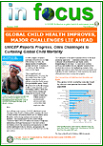|
DO INFO-TECHNOLOGY AND OTHER MEDIA SERVE FAMILY PHYSICIANS' NEEDS FOR HEALTH PROMOTION GUIDANCE TO THEIR PATIENTS?
CECHE funded Dr. Fiona Chew of the S.I. School of Public Communications, Syracuse University to conduct a pilot study to assess how well information technology and other media serve family physicians' needs for health promotion guidance to their patients? While Americans are knowledgeable about the link between diet and disease, this does not seem to translate into health promotion behavior. The leading causes of death in the U.S.- heart disease and cancer - are related to lifestyle factors and Americans are increasingly becoming overweight or obese. More attention is needed to inform and educate the public about health promotion and disease prevention. The American public relies on family physicians more than any other source for health information. As the "most credible" source of information for their patients, physicians should have access to the most accurate and up-to-date medical information sources via information technology and become aware of and informed about health promotion information. This pilot study surveyed physicians' use of information technology and related media including the Internet, television, conferences, pharmaceutical brochures and academic journals to assess their reliance on these sources for current and accurate health and medical information and identify ways to update their knowledge. Recent studies show that a large proportion of physicians use computers for personal or professional purposes. However, using information technologies for continuing medical education, clinical management, telemedicine and disseminating new knowledge and safety alerts have yet to be adopted widely. The study will also examine physicians' role as the "most credible" health information source for their patients and how these may be enhanced. The study, over the course of 12 months, was conducted by Dr. Fiona Chew of the S.I. School of Public Communications, Syracuse University with input from CECHE and the Syracuse-based Center for Evidence-based Practice at the Medical School, State University of New York. Predictability Model The study appled Roger's diffusion of innovations theory (1995), which postulates that the following factors predict the level of information technology adoption -- characteristics of innovation, training, organizational support, prior experience, and user's age. Based on Roger's theory, Chew et al project that physicians who integrate new information technology into their medical practice are more likely to perceive the following (see chart):
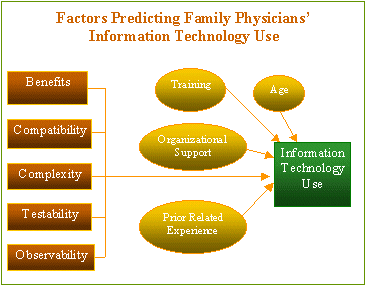
In addition, physicians more advanced in new information technology use are more likely to have had some information technology training and to have organizational support for its application. The applicants would also tend to be of younger age and have priorrelated experience in using technology to perform basic functions that are now transferred and applied to the new information technology. To test the prediction, Chew et al appled hierarchical regression analyses to the predictor variables and the use of information technology. The latter was measured by the extent of information technology use, e.g., Internet access at work, Internet use for clinical and updated information, email for professional communication, email for patient communication, use of hand-held medical computer, and use of electronic patient records. The Study In Spring of 2002, a mail survey was conducted among primary-care and family medicine physicians in the Greater Syracuse primarily to assess their use of information technology in clinical practice. Physicians were also asked about their sources of medical information, optimal methods of communicating bioterrorist alerts by national health agencies and perceptions of information technology. A four-page questionnaire was developed, pilot-tested and refined. Questions focused on current and proposed use of the computer and the Internet for clinical practice, as well as hand-held diagnostic computers, and electronic patient records. Aspects of patient communication using email were also examined. Other questions included sources of current health and medical information, preferred methods of communicating up-to-date bioterrorism information, and technology perceptions which may comprise potential barriers. Demographic information related to gender, number of daily patients, recency of professional training, and teaching hospital affiliation completed the survey instrument. The target population comprised members of the Syracuse Chapter of the American Academy of Family Physicians residing in the Syracuse metropolitan area. The group totaled 101 individuals and fieldwork took place between April 2 to June 3, 2002. With 58 physicians responding to the survey and 10 packages returned as undeliverable, a response rate of 63.7% was attained. Most of the sampled respondents (70.7%) were affiliated with a major teaching hospital. They comprised 58.6% male and 41.4% female. A majority of the group (55.1%) completed their professional training more than 10 years ago. On the whole, they saw about 26.8 patients a day ranging from a low of six to a high of 60 patients. Technological connectivity. More than nine in ten (93.1%) physicians reported having computers at work with about seven in ten using a computer at work (71.9%). Seventy-four percent had Internet access at work while 17.2% reported wanting to add this feature. Hand-held computers which assist in clinical diagnosis were used by 29.3% and desired by a similar proportion. Electronic record-keeping was used by 17.2% although a lot more (50%) reported wanting to convert to this system. On the home front, nearly nine in ten physicians (89.7%) had a computer with Internet access. 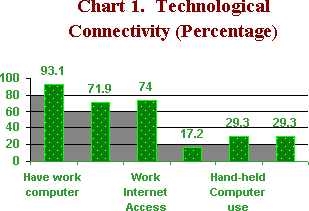
Patient communication. When asked about using Internet technology for patient communication, about one in four (24.6%) reported receiving patient email with about one in five (21.4%) replying to patients via email. In addition, 14.1% used email to send patients medically important information. 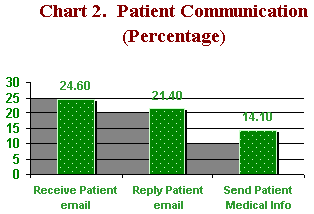
Sources of medical information. The source of information considered most helpful in keeping family physicians up-to-date in their medical practice was continuing medical education (mean score of 4.13 on a 1- scale where 1 was not at all helpful and 5 was very helpful). This was followed by medical journals (3.98 mean), professional colleagues (3.91 mean), and the American Academy of Family Physicians web site (3.45 mean). Bioterrorism updates. Email was cited by 38.8% as the best method of obtaining up-to-date information on bioterrorism agents. This was followed by fax (27.7%), other web sites (25%) and express mail (23.9%). 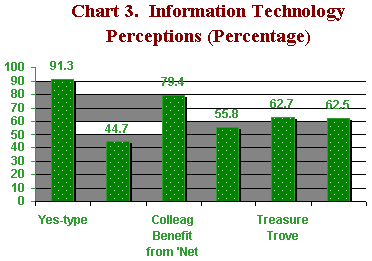
Information technology perceptions. When asked about the complexity of Internet use, a large majority (91.3%) reported being able to type and therefore able to use the computer. However, fewer than half (44.7%) felt that their Internet skills were excellent. In being able to observe Internet use, a sizeable majority (79.35%) agreed that their colleagues benefited from Internet use while a smaller group (55.8%) observed that Internet use has improved clinical practice. A majority agreed that Internet use had advantages such as getting "clinician's treasure trove" of information (62.7%) and a lot of useful information (62.5%). In the area of trialability, a majority (61.8%) was ready to try Internet use to see how it could improve their work while a much smaller proportion (38.9%) was ready to take a continuing medical education course on Internet navigation. When asked to assess the compatibility of Internet use, a slight majority (58.9%) thought that Internet use did not take too much effort although a minority (44.6%) reported having time to browse the Internet. Predicting the use of the Internet in the practice of medicine: An index of professional Internet use was created by summing the following variables: 1) use Internet at work, 2) get patient email, 3) reply to patient email, 4) send patient medical information by email, and 5) selecting email as the best method for getting bioterrorism informational updates. This was correlated with the ten variables assessing information technology perceptions. As expected, the measure of professional Internet usage was significantly associated with all the information technological perceptions (r=.27 to r=.42) except for the ability to type. Discussion and Conclusion The high number of family physicians who use computers and the Internet at work may be reflective of the large proportion of individuals in the sample who have affiliations with major teaching hospitals. As affiliates, these physicians often teach medical students and residents who are highly computer literate. Therefore, they bring that approach to patient care and want to take advantage of the latest technologies for their patients. The current use of and interest in hand-held computers for clinical diagnosis as well as electronic record-keeping similarly reflect this trend. The proportion of physicians who reported receiving patient email is consistent with national statistics. Overall, the results support the expectation that family physicians who were more likely to perceive technology benefits, compatibility, trialability, observability and ease of application integrated new information technology in their medical practice. As the first point of contact in the health care system for their patients, family physicians should have access to the most accurate and up-to-date medical information. This study found that most family physicians have observed how their colleagues benefited from Internet use. In addition, most clearly recognize the wealth of clinical information available at specific Internet sites and acknowledge that they themselves have obtained a lot of useful information from the Internet. Thus, online and computerized sources will continue to be valuable resources for family physicians. This point is reinforced by the finding that family physicians were more likely to rate email as the best method for communicating bioterrorism threats. This group most frequently identified continuing medical education as the most helpful source for keeping them updated in their practice of medicine. In combining this approach with an interest in how the Internet can improve their work, it is only a matter of time before a majority of physicians takes courses and increasingly uses information technology in their work to improve their Internet skills. |
|
|||||||||||
Questions? Comments? Concerns? E-mail CECHE at CECHE@comcast.net Go back to the CECHE home page Go back to the CECHE home page
|

